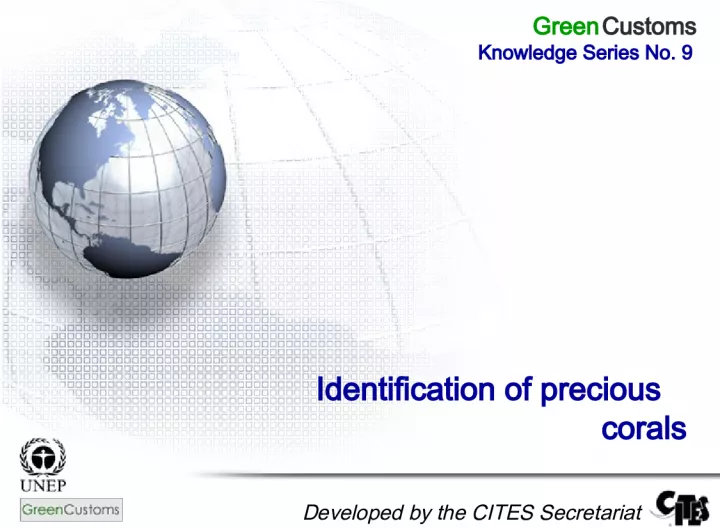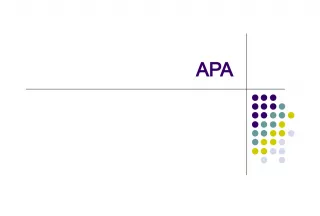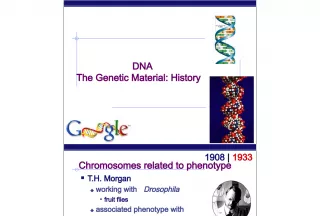Identification of Precious Corals: CITES Guidelines


Learn about which corals are classified as precious and how to identify them. Explore the CITES Appendices and distinguish between genuine and imitation precious corals. Corals are vital to marine ecosystems and crucial to protect.
- Uploaded on | 3 Views
-
 utkarsh
utkarsh
About Identification of Precious Corals: CITES Guidelines
PowerPoint presentation about 'Identification of Precious Corals: CITES Guidelines'. This presentation describes the topic on Learn about which corals are classified as precious and how to identify them. Explore the CITES Appendices and distinguish between genuine and imitation precious corals. Corals are vital to marine ecosystems and crucial to protect.. The key topics included in this slideshow are . Download this presentation absolutely free.
Presentation Transcript
1. Identification of precious corals Developed by the CITES Secretariat Green Customs Knowledge Series No. 9
2. 2 Questions to answer What corals are included in the CITES Appendices? Which of these are the precious corals? How to identify the different kinds of precious corals? How to identify imitation precious corals?
3. 3 Introduction Corals are marine organisms from the class Anthozoa and exist as small sea anemonelike polyps, typically in colonies of many identical individuals The group includes the important reef builders that are found in tropical oceans, which secrete calcium carbonate to form a hard skeleton
4. 4 Introduction These coral groups are included in the CITES Appendices Black coral Antipatharia spp., Appendix II Red and pink coral ( Corallium elatius , C. japonicum , C. konjoi , C. secundum - Appendix III , China) Blue coral Heliopora coerulea , Appendix II Stony corals SCLERACTINIA spp., Appendix II Organ-pipe corals Tubiporidae spp., Appendix II Fire corals Milleporidae spp., Appendix II Lace corals Stylasteridae spp., Appendix II
5. 5 The black, red/pink and blue corals comprise the precious corals used in jewelry and decoration Black coral Antipatharia spp., Appendix II Red and pink coral ( Corallium elatius , C. japonicum , C. konjoi , C. secundum - Appendix III , China) Blue coral Heliopora coerulea , Appendix II Introduction
6. 6 Precious corals Red and pink coral Corallium spp. is distinguished by their durable and intensely colored red or pink skeleton , which is used for making jewelry Black coral is a term given to a group of deep water, tree- like coral which normally occurs in the tropics Though its living tissue is brilliantly colored, black coral takes its name from the distinctive black or dark brown color of its skeleton Blue coral Heliopora coerulea is a naturally blue calcitic coral occasionally used in jewelry
7. 7 Red and Pink Coral Red and pink coral (Corallium) , the most valuable of the precious corals, has been fished for over 5,000 years Millions of items and thousands of kilograms per year are traded internationally as jewelry and in other forms Commercial yields of precious coral (all species) peaked in 1984 at 450 metric tons, declining to 40 mt by 1990, and fluctuating between 28 and 54 mt over the last 15 years
8. 8
9. 9 Uses of red and pink coral Jewelry Art objects Herbal or homeopathic medicine Red and Pink Coral
10. 10 Red and Pink Coral The trade in Corallium , primarily in the form of beads, dates to at least the Classical period and continued through the Middle Ages, with major exports of Mediterranean corals from Rome to India By the 17th century the major centers of the coral trade were in Naples, Marseilles and Livorno-Leghorn, with exports to India and West Africa Exports continued into the late 1800s, when Italy began importing large quantities of western Pacific Corallium from Japan and re-exporting processed coral beads to Asia and Africa
11. 11 Red and Pink Coral Features sufficient for reliable identification at the species level within the Corallium genus do not exist for skeletons or as manufactured jewelry and curios, which makes up the bulk of the trade Taxonomic identification of octocorals requires microscopic analysis of shape, size and color of sclerites (tiny calcified skeletal elements) embedded in the coenochyme and in the organic matrix of the axial skeleton; these are lost when processed for jewelry CoP14 Prop. 21
12. 12 Red and Pink Coral Is it Corallium ? True Corallium will exhibit a solid, pit-free, longitudinally striated surface Imitation Corallium such as glass, porcelain or dyed chalcedony can feel cold; plastic can feel warm; striations will not be parallel Dyed or polymer-impregnated corals of other species can be identified by their porous surface which may or not be filled in with polymer
13. 13 Red and Pink Coral Is it Corallium ? Corallium has a solid texturewith extremely few holes being visible in its polished external surface, other than a clusters of pin point holes that are the remnants of the corals central canal True Corallium is expensive
14. 14 Red and Pink Coral Is it Corallium ? Corallium can range in color from deep red to pink to almost white
15. 15 Red and Pink Coral Corallium rubrum
16. 16 Red and Pink Coral Corallium elatius (App. III)
17. 17 Red and Pink Coral Corallium secundum (App. III)
18. 18 Red and Pink Coral Corallium konojoi (App. III) Corallium japonicum (App. III)
19. 19 Corallium look-alikes Sponge coral (trade name) is made by dying red pieces of the gorgonian species Melithaea ochracea (non- CITES) It can be identified by its rough and porous surface; by lighter-hued reticulated pattern or brown patches or swirls that are still visible on polished surfaces; and by red pigment may be visible in defects, stringing holes and on the polished surface Sponge corals may also be resin impregnated to increase their durability
20. 20 Corallium look-alikes Sponge coral
21. 21 Corallium look-alikes Bamboo coral Keratoisis profunda (Family Isididae, non-CITES) is widely used as a Corallium substitute Bamboo corals possess a skeletal arrangement which resembles bamboo - the skeleton is composed of calcareous plates separated by joint-like gorgonin protein The natural color is creamy white with brown or black
22. 22 Corallium look-alikes Bamboo coral skeletons have a smoother surface than sponge coral and can display longitudinal striations like Corallium Sometimes the harder calcitic sections are cut out and dyed to make small beads; larger pieces may retain the banded patterning
23. 23 Bamboo coral
24. 24 Corallium look-alikes Bamboo coral using the calcitic sections only may be impossible to differentiate from Corallium , unless evidence of red dye can be seen under magnification
25. 25 Bamboo coral (dyed)
26. 26 Bamboo coral (natural)
27. 27 Corallium look-alikes When the internodes of bamboo coral are dyed red or pink, this color enhanced coral can be difficult to discriminate from Corallium unless evidence of residual dye or wax is observed
28. 28 Black Coral Black coral is a term given to a group of deep water, tree-like coral which normally occurs in the tropics ( Antipatharia spp. Appendix II ) Though its living tissue is brilliantly colored, black coral takes its name from the distinctive black or dark brown color of its skeleton The skeleton is made of a tough, keratin- like protein called conchiolin or gorgonin, which is not highly mineralized
29. 29 Black Coral Also unique to black coral are the tiny spines that cover the surface of the skeleton (black coral is also known as 'thorn coral' Properly prepared and polished pieces are near the equal of the stony types in durability and beauty, and can exceed them in value Black coral polishes very well, and colors range from black to dark brown to golden Black coral is 'thermoplastic' (it can be reshaped with heat)
30. 30 Black Coral Black coral can be identified by the presence of fine radially-arranged spines in unpolished sections, and remnants of the spines may be visible on polished surfaces under magnification Though superficially black, strong light can shine through surface layers, giving them a waxy brownish-red color against which the spine structure is obvious Applying a hot pin will release a 'salty burnt hair odor Cross-section cuts appears like a cross-section of a tree
31. 31 Blue Coral Blue coral Heliopora coerulea (App. II) is a natural colored blue calcitic coral that has limited value in jewelry due to its porosity The blue color is caused by the deposition of iron salts in the calcium carbonate skeleton The blue skeleton is also popular in the marine curio trade and is made into jewelry and ornaments The porous, relatively smooth surface has pores of two sizes - large pores of 0.7-1.0 mm diameter, and small pores of 0.1 mm diameter)
32. 32 Blue Coral (imitation) Imitation blue coral
33. 33 Summary The red/pink, black and blue corals are known as the precious corals These are widely used in jewelry and ornamentation Various non-CITES coral species may be dyed or otherwise processed to imitate precious corals Viewing under magnification (10x) may help identify precious corals
34. 34 CITES Secretariat Geneva www.cites.org























